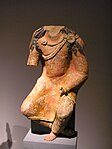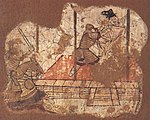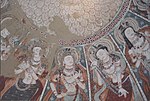Kumtura Caves
 Kumtula Grottoes | |
| Location | Xin gian g,China |
|---|---|
| Coordinates | 41°42′42″N82°40′42″E/ 41.7117°N 82.6784°E |
TheKumtura Thousand Buddha Caves(simplified Chinese:KhoMộcPhunRầmNgànPhậtĐộng;traditional Chinese:Kho mộc phun rầm ngàn Phật động;pinyin:Kùmùtǔlǎ Qiānfódòng) (also Qumtura; Uyghur:قۇمتۇرا) is a Buddhist cave temple site in theAutonomous RegionofXin gian g,China. The site is located some 25 km west ofKucha,Kuqa County,on the ancientSilk Road.[1][2]Other famous sites nearby are theKizilgaha caves,theKizil Caves,Subashi Templeand theSimsim caves.[3]
112 cave temples survive, dating from the fifth to the eleventh centuries. Damaged by occasional habitation after abandonment of the site, Kumtura was visited by a number of the early foreign expeditions to Chinese Central Asia, including the1902 Ōtani expedition,Oldenburg,andLe Coq.[4][5][6][7]The lastdetached several wall paintingsand took them back to Berlin (now at theMuseum für Asiatische Kunst).[8]
Construction of the Dongfang Hong Hydroelectric Plant in the 1970s caused the water level of theMuzat Riverto rise and has increased the rate of decay of the wall paintings.[1]Long-term preservation measures under the auspices ofUNESCObegan in 1999 with extensive documentation and survey work andconsolidationof theconglomerate rockfrom which the caves are excavated.[1][9]The site was among the first to be designated for protection in 1961 as aMajor National Historical and Cultural Site.[10]In 2008 Kumtula Grottoes was submitted for future inscription on theUNESCO World Heritage Listas part of the Chinese Section of the Silk Road.[11]
Gallery[edit]
-
Kumtura Caves overview
-
The Kumtura Grottoes are located along theMuzat River.
-
Kumtura Caves, sample plan
-
Headless statue from Kumtura at theMuseum für Asiatische Kunst,Berlin
-
Donors inHephthalitestyle, Kumtura Caves. Similar donors can be seen in theKizil Caves.[12][13]Circa 500 CE.[14][15]
-
Group of donors inTocharian clothing,Kumtura Caves.
-
Dignitary seized by soldiers. Kumtura painting, 8th-9th century CE
-
Statuettes ofDevatas,Kumtura
-
Man in royal attire, Kumtura Caves
-
Kumtura deity (dome)
-
Kumtura deity (dome)
-
Fresco on the dome
See also[edit]
- Principles for the Conservation of Heritage Sites in China
- National Heritage Sites in Xin gian g
- Ah-ai Grotto
- Kizil Caves
- Bezeklik Thousand Buddha Caves
- Mogao Caves
- International Dunhuang Project
References[edit]
- ^abcAgnew, Neville, ed. (2010).Conservation of Ancient Sites on the Silk Road: Proceedings of the Second International Conference(PDF).Getty Conservation Institute.pp. 37–9.ISBN9781606060131.
- ^Wang Weidong, ed. (2008).Kho mộc phun rầm hang đá nội dung tổng lục[A general record of the Kumtura caves] (in Chinese). Văn vật nhà xuất bản.ISBN9787501023844.
- ^(Other than Kizil)... "The nearby site of Kumtura contains over a hundred caves, forty of which contain painted murals or inscriptions. Other cave sites near Kucha include Subashi, Kizilgaha, and Simsim." inBuswell, Robert E.; Lopez, Donald S. (24 November 2013).The Princeton Dictionary of Buddhism.Princeton University Press. p. 438.ISBN978-1-4008-4805-8.
- ^"Japanese Collections".International Dunhuang Project.Retrieved28 April2012.
- ^"Russian Collections".International Dunhuang Project.Retrieved28 April2012.
- ^"German Collections".International Dunhuang Project.Retrieved28 April2012.
- ^Hopkirk, Peter(1984).Foreign Devils on the Silk Road: The Search for the Lost Cities and Treasures of Chinese Central Asia.University of Massachusetts Press.ISBN0870234358.
- ^"MIA Kumtura Collection".University of Washington.Retrieved28 April2012.
- ^"The Conservation and Restoration of Kumtura Thousand Buddha Caves".UNESCO.Archived fromthe originalon 18 January 2013.Retrieved28 April2012.
- ^"Quốc Vụ Viện về công bố nhóm đầu tiên cả nước trọng điểm văn vật bảo hộ đơn vị danh sách thông tri (1st Designations)"(in Chinese).State Administration of Cultural Heritage.3 April 1961. Archived fromthe originalon 9 June 2012.Retrieved28 April2012.
- ^"Chinese Section of the Silk Road".UNESCO.Retrieved28 April2012.
- ^Kageyama, Etsuko (2016)."Change of suspension systems of daggers and swords in eastern Eurasia: Its relation to the Hephthalite occupation of Central Asia"(PDF).ZINBUN.46:200-202.
- ^Kurbanov, Aydogdy (2014)."THE HEPHTHALITES: ICONOGRAPHICAL MATERIALS"(PDF).Tyragetia.8:324.
- ^MUZIO, CIRO LO (2008)."Remarks on the Paintings from the Buddhist Monastery of Fayaz Tepe (Southern Uzbekistan)".Bulletin of the Asia Institute.22:202, note 45.ISSN0890-4464.JSTOR24049243.
- ^"MIA Berlin: Turfan Collection: Kizil".depts.washington.edu.
External links[edit]
- Kumtura Thousand Buddha Caves Conservation Project (UNESCO)
- Conservation of Ancient Sites on the Silk Road (1st Conference) (GCI)
- Conservation of Ancient Sites on the Silk Road (2nd Conference) (GCI)
- Xin gian g Cultural Relics Bureau (search term: Kho mộc phun rầm ngàn Phật động )Archived2018-12-11 at theWayback Machine(in Chinese)
- Xin gian g Travel: Reliable & Authentic Guide from Local Travel Experts






![Donors in Hephthalite style, Kumtura Caves. Similar donors can be seen in the Kizil Caves.[12][13] Circa 500 CE.[14][15]](https://upload.wikimedia.org/wikipedia/commons/thumb/7/7e/Donors_from_Kumtura_Caves.jpg/90px-Donors_from_Kumtura_Caves.jpg)






